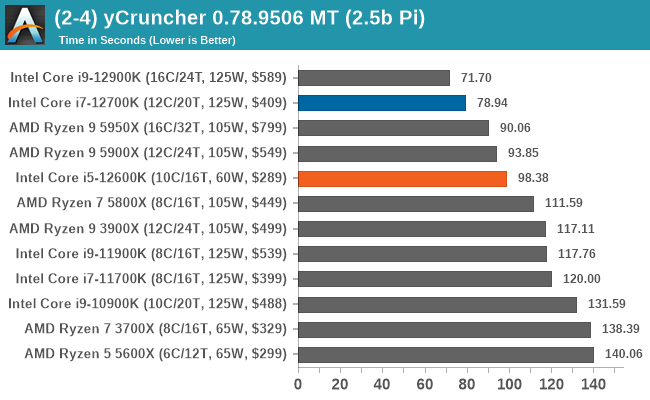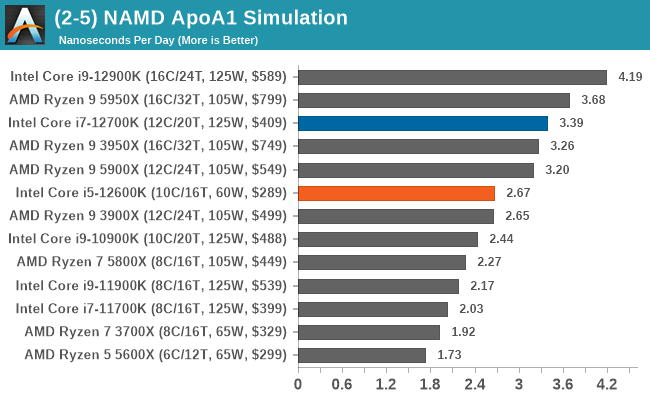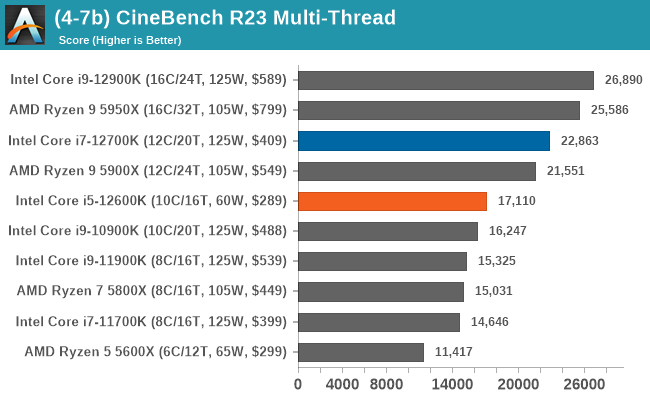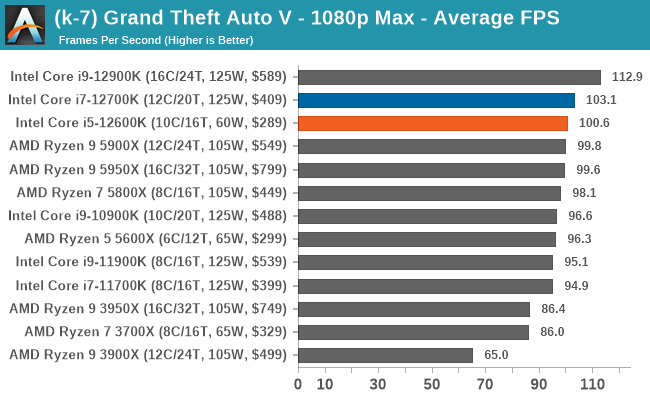The Intel Core i7-12700K and Core i5-12600K Review: High Performance For the Mid-Range
by Gavin Bonshor on March 29, 2022 8:00 AM ESTConclusion
As we make good headway into 2022 and beyond, the dynamic of the CPU market is constantly changing and evolving. What was once for many years a war based on core count on chips between Intel and AMD has now become a battle of whose core performs more efficiently, is faster, and offers better value. It's no surprise that both of Intel and AMD's flagship offerings (Core i9-12900K versus Ryzen 9 5950X) have been one based on everything but value; both companies have respectively changed the desktop processor market for the better.
In what is possibly our final look at Intel's 12th Gen Core series processors, I feel that it has been a successful launch for one main reason. This all comes down to value, as 12th Gen Alder Lake has been one of the first Core series since AMD launched its Zen architecture back in 2017 to offer users something that feels like good value for the price, compared to what it has done in the past. Not only that, but Intel has bridged the gap between themselves and AMD with improved IPC performance, which leapfrogs AMD's Zen 3 architecture. Another element is in multi-threaded applications. The increased IPC with the Golden Cove P-Cores combined with its Gracemont E-Cores helps negate some of AMD's Ryzen 5000 series previous dominance in certain situations where higher core counts are favored.
The 12-Core to 8-Core Desktop Processor Market: Alder Lake Makes a Splash
While it has been noted by several outlets and retailers over the last month, AMD has finally cut the pricing on its Ryzen 5000 series desktop processors. This doesn't just feel like a ploy from AMD to increase competitiveness against Intel's 12th Gen Core offerings. Still, it's notable that it's taken AMD this long to catch up with demand for their chips. It underscores how everything below high-end/flagship CPUs has been rather underserved for the last year and a half, as chip shortages have sent resources elsewhere.
Turning back to now, and as it stands, Intel's Alder Lake offers more in terms of performance for the price, especially in the sub $450 processor market.
| Intel Versus AMD Mid-Range Price Comparison (as of 03/20) | ||||||
| Intel Core 12th Gen |
Cores | Price ($) |
Price ($) |
Cores | AMD Ryzen 5000 |
|
| Core i7-12700K | 8+4 (12) | $385 | vs. | $485 | 12C | Ryzen 9 5900X |
| Core i5-12600K | 6+4 (10) | $279 | vs. | $390 | 8C | Ryzen 7 5800X |
As well as AMD's recent price drops on its Ryzen 5000 offerings, we've been noticing small and subtle price drops on Intel's 12th Gen Core series too. This means that despite the Ryzen 9 5900X, which is currently on sale for $485 at Amazon, is undoubtedly a better price than it was ($570), the Intel Core i7-12700K is now available at the lower cost of $385 at Amazon. Intel's offering better value and is around 20% cheaper when comparing both chips at Amazon; other retailers may vary.
Looking at the differentials in the other battle between the Core i5-12600K and Ryzen 7 5800X, the same can also be applied. The Ryzen 7 5800X, which now costs $390 at Amazon, is down from $450. In contrast, the Core i5-12600K is available for $280 at Amazon, which means Intel is around 20% cheaper on its 10-core 12th Gen series chip.
It's worth noting that due to AMD's Zen 3 chiplet design, its Core Chiplet Die (CCD) is limited to 1 x CCD of 6-cores and 8-cores at the moment, meaning an actual 10-core competitor to the Core i5-12600K isn't viable, at least from a cost and yield standpoint. AMD could release a 10-core Ryzen 5000 processor if it disabled cores on one of the CCDs, but this again wouldn't be viable from AMD's perspective.
Intel is currently winning the pricing war when it comes to the value proposition in both the respective markets (12C and 10/8C). This can and would only change if AMD decided to cut its pricing even further, though at this point the deciding factor doesn't seem to be Alder Lake's performance, but rather how much of AMD's 7nm wafer allocation is being consumed by higher margin products like EPYC chips. Make no mistake, Intel's mid-range and enthusiast class Alder Lake chips are legitimately good, but there's also an element of "winner by default" at play due to AMD's seemingly limited chip volumes in these segments.
Core i7-12700K and Core i5-12600K Performance Analysis:
Focusing on the performance of both the Core i7-12700K and Core i5-12600K, both processors are competitive and have viable trade-offs against the competition. For the purposes of acknowledgment, we've included both the Core i9-12900K and Ryzen 9 5950X into our data arc for this review. This allows us to better judge the propositions of value and competition throughout Intel's Alder Lake offerings and AMD's Ryzen 5000 desktop chips.

Taking a look at some benchmarks that reasonably conclude the landscape of the desktop market, our science-based yCruncher benchmark shows the natural levels of performance when comparing Alder Lake to Zen 3. In this test, the Alder Lake-based 12th Gen Core processors outperform each of their market rivals. The Core i5-12600K sits between both the Ryzen 9 5900X and the Ryzen 7 5800X here, which is relative to the core count and the difference in IPC performance between both architectures.

In another science-focused benchmark, both the Core i7-12700K and Core i5-12600K perform well in respect to the competition. The NAMD ApoA1 simulation benchmark favors a mixture of core/thread count, with faster cores at equal core counts proving more effective.

The popular Cinebench R23 benchmark is used often by manufacturers and media alike to show off rendering performance across the single and multi-threaded performance. We already know that Alder Lake has an IPC advantage over Zen 3, as seen in our previous Core i9-12900K and Core i3-12300 reviews, so we're focusing on multi-threaded performance here.
Both the Core i7-12700K and Core i5-12600K perform well in the Cinebench R23 Multi-Thread test, and while it's notable that the flagship Core i9-12900K reigns supreme, the Core i7-12700K isn't too far behind the Ryzen 9 5950X, which is exceptional.
While it is fair to say that the use of DDR5 memory on Alder Lake is definitely a contributing factor to some of the extra performance gains, it's fair to judge performance based on the achievable performance using the best technologies available. Overall, the Core i7-12700K is perhaps the best sub $400 processor from a price to performance point of view, and this is confirmed throughout our testing. In contrast, using Windows 11 over Windows 10 yields little gain, and we also test with memory settings based on what the chip is capable of based on JEDEC settings.

The recent offerings from both Intel and AMD perform well in gaming, with much of the variation in performance surrounding what each of the game developer's titles is aligned with. This means that game titles that partner with Intel generally performs better due to code and integrated technologies. At the same time, AMD has the same thing with the developers it partners with. The overall situation in gaming performance is quite simple; all of the 8C+ processors from both team Intel (Alder Lake) and team AMD (Zen 3) all perform well, with slight nuances based on the game developer's level of its multi-threaded application being another contributing factor to performance.
Summary
Selecting a processor to build a new system or upgrade an existing one, both Intel and AMD have plenty of options for users to sink their teeth into. There's something for everyone when it comes to selecting the best processor for the task at hand, be that rendering, a workstation, a gaming system, or even just for web-browsing.
Getting straight to the point on our opinion of Intel's 12th Gen Core i7-12700K and Core i5-12600K processors, both perform very well and are the best all-round performers at their respective price points. When it comes to selecting a processor between $250 and $450 for a gaming system, it makes very little sense than to opt for the Core i5-12600K, as it has a good balance of cores (10C/16T) with enough performance on those cores to make it a no brainer for $279.

The Intel Core i5-12600K (left) and Core i7-12700K (right) processors.
The extra money saved opting for the Core i5-12600K over the Core i7-12700K could be put towards a better video card, which would offer a more significant jump in frame rates over opting for the more expensive processor. It's clear that the Core i7-12700K and Core i5-12600K are a better buy, both from a value and performance perspective over the competing AMD Ryzen 5000 series processors.
Overall, Intel's Alder Lake architecture is an important win for the company that has consistently lost desktop processor market share since Zen debuted back in 2017. Even with the launch of AMD's Ryzen 7 5800X3D, due on April 20th, it's more likely to be competitive with the Core i7-12700K in gaming, and if its 96 MB of 3D V-Cache is as effective in gaming as AMD suggests, it could be neck and neck there. However, the Core i7-12700K benefits from an unlocked multiplier, and system tweakers are more likely to get a better price to performance ratio with Intel.
Right now, Alder Lake has the competitive advantage over Zen 3, and that's to be expected, as this is the second attempt from Intel to close the gap between itself and AMD's Ryzen 5000 lineup. The biggest question is, what's on the horizon? We know AMD is planning to release its Zen 4 5 nm based processors sometime this year, and the generational gap between Zen 2 and Zen 3 was very impressive. It still remains to be seen how that pans out, but for now, Intel's 12th Gen Core series is certainly worthy of consideration, especially with its more aggressive pricing.










196 Comments
View All Comments
Gondalf - Tuesday, March 29, 2022 - link
Beh! in short words Intel have the best 7nm (or 7nm equivalent) desktop cpu, this is pretty evident.Same applies to Mobile parts obviously. AMD approach look like rudimentary and silicon hungry versus Intel big-little silicon.
We'll see on finer nodes next year or so. Still i have the idea that Intel will never be anymore behind AMD like in past years.
eek2121 - Tuesday, March 29, 2022 - link
Keep in mind that Zen 4 is coming later this year and will make Alder Lake 2nd again. The flip/flop continues.From a technology standpoint AMD has the best setup. They can just add chiplets or cores to increase multicore performance.
They have 90-95% of the performance for less than half, or in some cases, 1/3rd the power.
Stop trolling. It makes you look immature and childish.
DannyH246 - Tuesday, March 29, 2022 - link
Yup. Completely agree, Intel are finally competitive with what? A 2yr old AMD product, but at triple the power. Yet some of the posters on here are acting like Intel are saviors who have finally returned to save us all from our PC ills. They forget that Intel literally screwed us all for a decade with high prices, feature lock outs, core counts limited to 4, new motherboards required every year, anti competitive behavior, and anti consumer practices. Why anyone would want Intel to return to the dominant position that they used to occupy is beyond me.Khanan - Tuesday, March 29, 2022 - link
Fully agree.lmcd - Tuesday, March 29, 2022 - link
Pretty delusional here -- AMD's whole plan with Bulldozer was to create vendor lock-in where you used an AMD GPU to accelerate floating point operations on an AMD CPU. Consumer-friendly to claim 4 cores are really 8? Thuban outperformed Piledriver until its instruction set finally was too limited years later. AMD just wanted a marketing point.Also, how are you playing both narratives at once? Intel both wasn't willing to deliver more than 4 cores and has too high of power consumption in its parts with more than 4 cores? Which is it? Because it quite literally cannot be both.
Samus - Wednesday, March 30, 2022 - link
OMG people are still going on about the shared FPU BS.It HAD to be that way. The entire modular architecture was built around sharing L2 and FPU's. There was nothing inherently wrong with this approach, except nobody optimized for it because it had never been done, so people like you freaked out. If you wanted your precious FPU's for each integer unit, buy something else...
Otritus - Wednesday, March 30, 2022 - link
It did NOT have to be that way. AMD intentionally chose to share the fpu and cache creating a cpu that was abysmal in performance and efficiency, and deceptive in marketing. Thuban was a better design, so updating the instruction set would have made a better product than bulldozer.I along with most people chose to buy something else (Sandybridge to Sky Lake). The lack of a competitive offering from AMD created the pseudo monopoly from Intel, and many people rightfully complained about the lack of innovation from Intel.
Also there is no optimizing for hardware that isn’t physically present. 4 fpus means 4 cpu cores when doing floating point tasks, which is highly consequential for gaming and web browsing.
There is no arguing for AMD’s construction equipment family. It sucked, just like Intel’s monopolistic dominance and Rocket Lake.
AshlayW - Wednesday, March 30, 2022 - link
FYI, most instructions in day to day workloads are integer, not floating point. Your argument that Floating point is "highly consequential" for gaming and web browsing is false.mode_13h - Thursday, March 31, 2022 - link
> most instructions in day to day workloads are integer, not floating point.Sure. Compiling code, web browsers, most javascript, typical database queries... agreed.
> Your argument that Floating point is "highly consequential" for gaming
LOL, wut? Gaming is *so* dominated by floating point that GPUs have long relegated integer arithmetic performance to little more than their fp64 throughput!
Geometry, physics, AI, ...all floating point. Even a lot of sound processing has transitioned over to floating-point! I'm struggling to think of much heavy-lifting typical games do that's *not* floating point! I mean, games that are CPU-bound in the first place - not like retro games, where the CPU is basically a non-issue.
Dolda2000 - Saturday, April 2, 2022 - link
While games certainly do use floating-point to an extent where it matters, as a (small-time) gamedev myself, I'd certainly argue that games are primarily integer-dominated. The parts that don't run on the GPU are more concerned with managing discrete states, calculating branch conditions, managing GPU memory resources, allocating and initializing objects, just managing general data structures, and so on and so forth.Again, I'm not denying that there are parts of games that are more FP-heavy, but looking at my own decompiled code, even in things like collision checking and whatnot, even in the FP-heavy leaf functions, the FP instructions are intermingled with a comparable amount of integer instructions just for, you know, load/store of FP data, address generation, array indexing, looping, &c. And the more you zoom out of those "math-heavy" leaf functions, the lesser the FP mix. FP performance definitely matters, but it's hardly all that matters, and I'd be highly surprised if the integer side isn't the critical path most of the time.